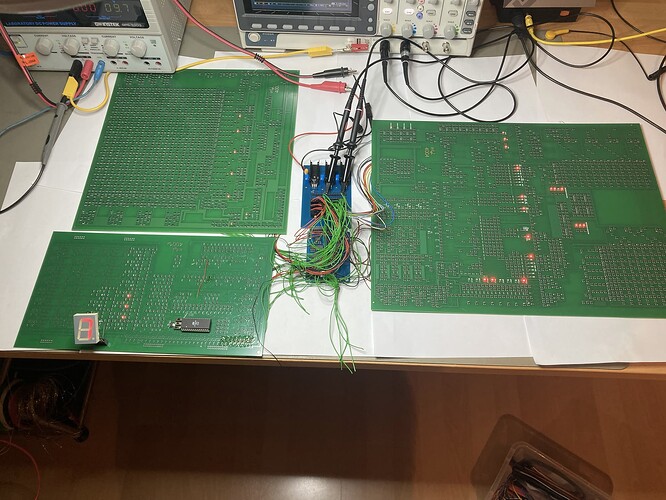To celebrate the 52nd Anniversary of Intel’s November 15, 1971 product
launch of the now-historic 4004 microprocessor,
Swiss physicist, Klaus Scheffler, in a world’s first, built
a complete 4-bit computer based on Intel’s original 4004 schematics
using nearly 4,000 discrete SMD transistors on three giant printed
circuit boards. He proved his computer works stand-alone by running an
algorithm that computes digits of Pi. This achievement was an
international collaboration with Hungarian mathematician, Lajos
Kintli, who worked with Scheffler from afar to debug the printed
circuit “microprocessor,” by writing assembly-language algorithms for the
4004, “board bring-up” test software running on a Teensy, and Kintli’s
indispensable circuit analyzer and verification software that made it possible for
Sheffler to build and debug his fledgeling, printed circuit 4004
incrementally, comparing it against “oscilloscope traces” from
Kintli’s known-working simulation of the entire 4004-family
chip-set. But Scheffler did not stop there. After he got his
transistor 4004 working, he went on to build a transistor 4002 RAM and
a hybrid ROM+I/O board to create a complete, stand-alone, 4-bit
computer. This project is a testament that a “big hack” (the good
kind) can be accomplished by a small team of dedicated hobbyists or
even solo, working just a few hours a week, yet persisting for months
despite the inevitable technical challenges.
Author’s note: I just submitted this story to Slashdot
If you like what you just read, please consider visiting the submission page, and up-voting the submission. Before they changed ownership, Slashdot routinely published my articles. Nowadays, I’m less certain. But it’s a fun “big hack,” retro project these guys did, and I think they deserve the attention.
